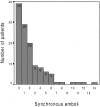Clinical implications for the management of acute thromboembolic occlusion of the superior mesenteric artery: autopsy findings in 213 patients
- PMID: 15729076
- PMCID: PMC1356992
- DOI: 10.1097/01.sla.0000154269.52294.57
Clinical implications for the management of acute thromboembolic occlusion of the superior mesenteric artery: autopsy findings in 213 patients
Abstract
Objective: To study findings at autopsy in patients with fatal acute thromboembolic occlusion of the superior mesenteric artery (SMA).
Summary background data: Acute occlusion of the SMA is difficult to diagnose and mortality remains high. In Malmo, Sweden, the autopsy rate between 1970 and 1982 was 87%, creating possibilities for a population-based study.
Methods: Among 23,496 clinical autopsies and 7569 forensic autopsies, 213 cases with acute thromboembolic occlusion of the SMA and intestinal infarction were identified.
Results: A clinical suspicion of intestinal infarction was documented in 32% of the patients, only 35% being in the care of surgeons. The embolus/thrombus ratio was 1.4 to 1. Thrombotic occlusions were located more proximally than embolic occlusions (P < 0.001), intestinal infarction was more extensive (P = 0.025) and thrombotic occlusions were associated with old brain infarction (P = 0.048), aortic wall thrombosis (P = 0.080), and disseminated cancer (P = 0.079). Patients with embolic occlusions (n = 122) had a higher frequency of acute myocardial infarction (AMI) than patients with thrombotic occlusions (P = 0.049). The embolic source was identified in 80%. In 115 (94%), synchronous embolism and/or source of embolus were present. There were findings of remaining cardiac thrombi in 58 (48%) and synchronous emboli affected 273 other arterial segments in 83 (68%).
Conclusions: Early recognition and revascularization would have been a prerequisite for survival in at least half of the patients, since the jejunum, ileum, and colon were affected by infarction. A minority of all patients were under surgical care. AMI, cardiac thrombi, and synchronous emboli were common findings among patients with embolic occlusions.
Figures



References
-
- Boley SJ, Brandt LJ, Sammartano RJ. History of mesenteric ischemia. Surg Clin North Am. 1997;77:275–288. - PubMed
-
- Batellier J, Kieny R. Superior mesenteric artery embolism: eighty-two cases. Ann Vasc Surg. 1990;4:112–116. - PubMed
-
- Edwards M, Cherr G, Craven T, et al. Acute occlusive mesenteric ischaemia: surgical management and outcomes. Ann Vasc Surg. 2003;17:72–79. - PubMed
-
- Eldrup-Jorgensen J, Hawkins R, Bredenberg C. Abdominal vascular catastrophes. Surg Clin North Am. 1997;77:1305–1320. - PubMed
MeSH terms
LinkOut - more resources
Full Text Sources

